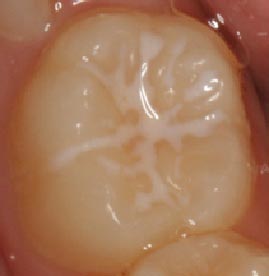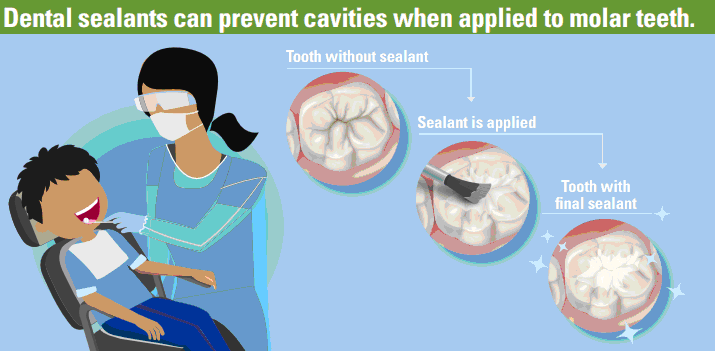You’ve probably heard of them, but many parents are unfamiliar with the small, yet important details regarding dental sealants, including what exactly a sealant is, why they’re used, and how they’re applied. We’ll give you the low-down and provide you with the important facts you need to know to help protect your child from getting tooth decay.
What are dental sealants?
Dental sealants are a thin coating that is applied to the pits and fissures (aka “grooves”) of back teeth to help prevent penetration of bacteria, sugars, germs, and other cavity-causing substances. By painting on what looks like a thin layer of white nail polish, the chewing surfaces of teeth are easily protected against getting cavities. Sealants specifically protect the biting surfaces of the teeth, where cavities commonly start. When a sealant is applied, it keeps bacteria and other food particles out of the grooves, significantly decreasing the risk of getting cavities.
Which teeth should get sealants?
Any tooth with deep grooves on the biting surface can benefit from sealant coverage. Most commonly, permanent molars (generally the 6-year-molars and the 12-year-molars) benefit the greatest from sealants. Often times the “premolars,” which are the permanent teeth that replace the baby molars, and sit between the permanent canines and permanent molars can also benefit from sealants. Baby teeth typically don’t have as deep of grooves as permanent teeth, so sealant application isn’t as common on these teeth, but there are exceptions.
How are sealants applied?
 Getting sealants is easy! There is no numbing medicine or drilling required. The process is relatively short and can often be done during your cleaning and checkup appointment. First, a gel is placed over the grooves of the tooth to ensure it tooth is thoroughly cleaned. The tooth is then rinsed off and dried. An adhesive layer is painted onto the tooth, followed by the sealant, which resembles white nail polish. Just enough is applied to cover the grooves of the teeth. Once the dentist has carefully applied the sealant material, a blue LED light is used to harden the sealant. In total, it takes just about 60 seconds to complete the sealant application process. Sealants can be white or clear, and generally aren’t visible unless looking close up. Because they are painted on back teeth only, they are usually not visible when a patient talks to smiles.
Getting sealants is easy! There is no numbing medicine or drilling required. The process is relatively short and can often be done during your cleaning and checkup appointment. First, a gel is placed over the grooves of the tooth to ensure it tooth is thoroughly cleaned. The tooth is then rinsed off and dried. An adhesive layer is painted onto the tooth, followed by the sealant, which resembles white nail polish. Just enough is applied to cover the grooves of the teeth. Once the dentist has carefully applied the sealant material, a blue LED light is used to harden the sealant. In total, it takes just about 60 seconds to complete the sealant application process. Sealants can be white or clear, and generally aren’t visible unless looking close up. Because they are painted on back teeth only, they are usually not visible when a patient talks to smiles.
Do sealants hurt?
No! Getting a sealant is much, much easier than getting a filling. Because there is no drilling, no anesthetic is required. The only requirement is that the patient keep their mouth open for about one whole minute so the dentist can reach the back of the mouth where the molars are. If the tooth gets wet with saliva during the application process, the quality of the sealant bond is compromised and the sealant must be re-applied. Some children report a sour after-taste, but this is easily rinsed away with water.
How long will sealants last?
If done correctly, sealants can last up to 10 years! When the doctor is painting on the sealant, it is critical that the tooth stay dry and free of saliva to enhance the bond to the tooth. For kids who have a hard time staying open, a sensitive gag reflex, or a curious tongue, sometimes sealant application can become more of a challenge. Your dentist will help determine when the right time for sealant application is for your child. For the most part, sealants will last for a number of years, but it is not uncommon for sealants to begin to chip away at the edges with regular wear and tear. At each checkup appointment, your child’s dentist will evaluate the integrity of the sealant and offer to re-apply as needed.
Does insurance pay for sealants?
Because sealants are considered a “preventive” procedure, insurance companies are more generous in paying for sealants. Some insurance companies will pay for sealants once per year, once every 3 or 5 years, or sometimes just once in a lifetime. Some insurance companies also put age limits on sealants. If you have any doubt, or are unsure what your sealant coverage is, we can help you determine your sealant benefit with your insurance company.
The facts
According to the American Academy of Pediatric Dentistry, the most common place to get cavities is in the grooves (aka pits and fissures) of the back teeth. Research has shown that dental sealants can prevent 80% of cavities occurring in back teeth. Sealants can also have prevent small cavities from growing larger in size by sealing out sugars and bacteria.
Our take on sealants
Sealants are easy! And the benefit of getting a sealant far outweighs the burden of getting a filling. All in all, sealants can save you and your family time, money, and the stress of potential scary dental appointments. They’re easy and fast enough to generally be done at your checkup appointment, so no extra trips to our office. Call us today to set up your next checkup and see if your child needs sealants!

